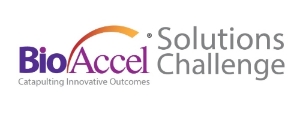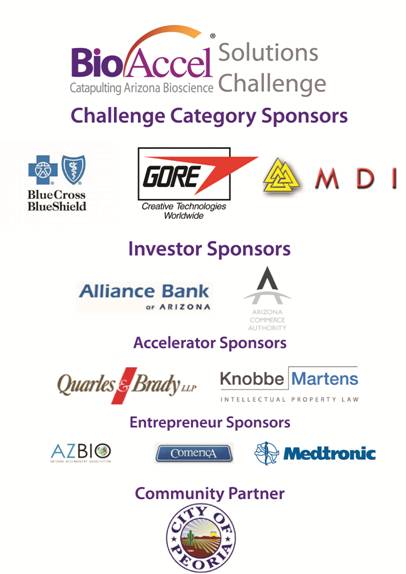Our Needs + Your Solutions = $100,000
BioAccel’s Solutions Challenge 2015 is a contest to identify solutions to challenges faced by BioAccel’s clinical partners.
Apply and compete for up to $100,000 to develop your product and company with full prototyping, legal, business, technical, and regulatory support from BioAccel, an experienced medical technology investor and accelerator. Below, please find the description of this year’s challenge categories, and visit www.bioaccel.org/solutionschallenge for additional details and access to the application form.
All submissions are due by February 1st 2015!
2015 Challenge Categories
Challenge Category # 1: Digital, Wearable and Mobile Health The Nexus of Hardware, Software and Behavior
Patient Behavior Modifying Systems: Predictive, preventative, and telehealth interventions are increasingly central to the future of affordable, timely care, with nearly 60% of physicians and insurers believing that widespread adoption of mobile health applications in the near future is inevitable. “Primary care technicians” supported by wireless technology may dramatically expand the efficiency and reach of physicians, enabling a combination of digital, wearable, behavioral technologies that ensure patient compliance and predict and prevent costly adverse events. The ability to seamlessly and remotely monitor blood oxygen saturation, blood glucose, and cardiac function are just a few ideas that could save payers and providers billions of dollars in unnecessary complications and hospital readmissions each year. Clinical Behavior Modifying Systems: Pilots utilize autopilot and early warning systems and checklists because lives depend on them. We have an emerging opportunity to master this kind of human / technology interaction in the medical theater. We need cost effective error reducing, efficiency enhancing, behavior optimizing, and project implementation tracking clinical systems and software in that save lives, improve the quality of care, and reduce costs. Automated surgical assistants and psychological assessments for bedside manner are examples that could save the healthcare system between 84 and 151 billion dollars per year. Keystroke logs for efficient utilization of EMR software could save up to an estimated $32,409 per physician per implementation and free physicians to concentrate on patients.
Challenge Category #2: Regenerative Wound and Aesthetic Therapy
Traditionally dominated by sealants and products focused on keeping the wound bed clean, dry, and moist, novel treatments must also consider tissue oxygenation, nutrition, regeneration, and cosmetic effects. This is especially critical as compromised populations (e.g. obese, diabetic, elderly) may require 6 months to a year for proper wound closure, costing an additional $10,000 to $52,000 per patient in dressings and home health visits. Innovative technologies that increase the rate of healing can significantly reduce these costs and improve patient quality of life.
Challenge Category #3: Simplified Access to Care Identified and Sponsored by Blue Cross Blue Shield of Arizona
The National Center for Health Statistics released a study citing 79.7% of adults visited the emergency room (ER) due to lack of access to other providers, 48% because the doctors’ office was closed and 45% because it was close to their homes. Treatment at an ER is significantly more expensive than in an urgent care center or doctors’ office. To change behavior and avoid unnecessary costs, finding a facility, making an appointment, and getting there must be easy, convenient, and provide choice. A well designed technology solution that removes barriers to preventive care in a way that works for peoples’ lifestyles will affect engagement and satisfaction. The solution should consider all care settings where primary care can be scheduled or delivered, including the home. We want to make it pleasant and convenient for all patients to proactively utilize preventative primary care to reduce unnecessary and costly ER visits. This is especially critical for the underserved populations who are have recently entered the healthcare market.
Challenge Category #4: A New Approach to Eliminating Type 2 Endoleaks Identified and Sponsored by W.L Gore
Abdominal Aortic Aneurysm is a potentially fatal condition especially prevalent in men over the age of 65. Whereas previous interventions were costly, risky and traumatic for elderly patients, minimally invasive endo-vascular stent grafting has become the gold standard of care. This technique enables the relining of diseased segments of the abdominal aorta using catheter-based devices and eliminates the need for open surgery in a majority of patients. Despite the success and wide adoption of this technology, there remain limitations that at times require further endovascular or surgical intervention. One such limitations is the occurrence of Type 2 endoleaks. These occur when small arteries branching from the aneurysm sac continue to allow blood to flow in and pressurize the aneurysm. The prevention of this complication through novel, innovative and minimally invasive approaches and solutions could significantly improve the clinical outcomes and economics of aneurysm repair.
Challenge Category #5: Wildcard for Student Entrepreneurs Sponsored by Molded Devices
Developing the next generation of biomedical entrepreneurs is critical to the sustainability and success of the biomedical industry. We’ve opened this category to any and all minimally and non-invasive medical device technologies originating from current or recently graduated student teams.


